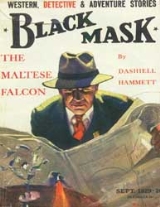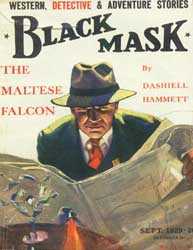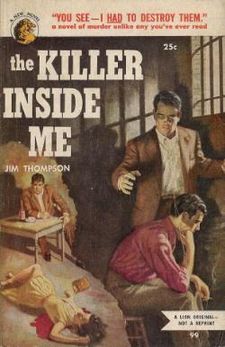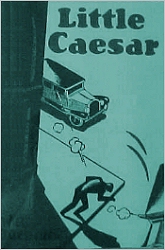
Hardboiled
Encyclopedia

Crime fiction
Crime fiction is the literary genre that fictionalizes crimes, their detection, criminals and their motives. It is usually distinguished from mainstream fiction and other genres such as science fiction or historical fiction, but boundaries can be, and indeed are, blurred...
is a literary style, most commonly associated with detective stories
Detective fiction
Detective fiction is a sub-genre of crime fiction and mystery fiction in which an investigator , either professional or amateur, investigates a crime, often murder.-In ancient literature:...
, distinguished by the unsentimental portrayal of violence and sex. The style was pioneered by Carroll John Daly
Carroll John Daly
Carroll John Daly was a writer of crime fiction. He has been credited with creating the first hard-boiled detective story in 1923 with "Knights of the Open Palm," published June 1, 1923 in Black Mask magazine, featuring private detective Race Williams; the first appearance of Williams predated the...
in the mid-1920s, popularized by Dashiell Hammett
Dashiell Hammett
Samuel Dashiell Hammett was an American author of hard-boiled detective novels and short stories, and political activist. Among the enduring characters he created are Sam Spade , Nick and Nora Charles , and the Continental Op .In addition to the significant influence his novels and stories had on...
over the course of the decade, and refined by Raymond Chandler
Raymond Chandler
Raymond Thornton Chandler was an American novelist and screenwriter.In 1932, at age forty-five, Raymond Chandler decided to become a detective fiction writer after losing his job as an oil company executive during the Depression. His first short story, "Blackmailers Don't Shoot", was published in...
beginning in the late 1930s.
From its earliest days, hardboiled fiction was published in and closely associated with so-called pulp magazines, most famously Black Mask under the editorship of Joseph T. Shaw. In its earliest uses in the late 1920s, "hardboiled" didn't refer exclusively to a type of crime fiction; it meant any tough and violent fiction, which also included adventure and western stories. Pulp historian Robert Sampson argues that the "Don Everhard" stories by
Gordon Young in Adventure
Adventure (magazine)
Adventure magazine was first published in November 1910 as a monthly pulp magazine. Adventure went on become one of the most profitable and critically acclaimed of all the American pulp magazines...
magazine, about
a gun-toting urban gambler, anticipated the "hard-boiled" detective stories. The exclusive reference to crime fiction probably became fixed in the early 1930s, although it's impossible to pin down with precision. The hard-boiled crime story became
a staple of several pulp magazines in the 1930s; in addition to Black Mask, hard-boiled crime fiction
appeared in Dime Detective and Detective Fiction Weekly. Later, many hardboiled novels were published by houses specializing in paperback originals, also colloquially known as "pulps." Consequently, "pulp fiction" is often used as a synonym for hardboiled crime fiction. In the United States, the original hardboiled style has been emulated by innumerable writers, including Chester Himes
Chester Himes
Chester Bomar Himes was an American writer. His works include If He Hollers Let Him Go and a series of Harlem Detective novels...
, Mickey Spillane
Mickey Spillane
Frank Morrison Spillane , better known as Mickey Spillane, was an American author of crime novels, many featuring his signature detective character, Mike Hammer. More than 225 million copies of his books have sold internationally...
, Ross Macdonald
Ross Macdonald
Not to be confused with John D. MacDonaldRoss Macdonald is the pseudonym of the American-Canadian writer of crime fiction Kenneth Millar...
, John D. MacDonald
John D. MacDonald
John Dann MacDonald was an American crime and suspense novelist and short story writer.MacDonald was a prolific author of crime and suspense novels, many of them set in his adopted home of Florida...
, Robert B. Parker
Robert B. Parker
Robert Brown Parker was an American crime writer. His most famous works were the novels about the private detective Spenser. ABC television network developed the television series Spenser: For Hire based on the character in the late 1980s; a series of TV movies based on the character were also...
, Sara Paretsky
Sara Paretsky
Sara Paretsky is a modern American author of detective fiction.-Life and career:Paretsky was born in Ames, Iowa and raised in Kansas, graduating from the University of Kansas with a degree in political science. She did community service work on the south side of Chicago in 1966 and returned in...
, Sue Grafton
Sue Grafton
Sue Taylor Grafton is a contemporary American author of detective novels. She is best known as the author of the 'alphabet series' featuring private investigator Kinsey Millhone in the fictional city of Santa Teresa, California. The daughter of detective novelist C. W...
, and Walter Mosley
Walter Mosley
Walter Ellis Mosley is an American novelist, most widely recognized for his crime fiction. He has written a series of best-selling historical mysteries featuring the hard-boiled detective Easy Rawlins, a black private investigator and World War II veteran living in the Watts neighborhood of Los...
.
The term comes from a colloquial phrase of understatement. For an egg, to be hardboiled is to be comparatively tough. The hardboiled detective—originated by Daly's Terry Mack and Race Williams and epitomized by Hammett's Sam Spade
Sam Spade
Sam Spade is a fictional character who is the protagonist of Dashiell Hammett's 1930 novel The Maltese Falcon and the various films and adaptations based on it, as well as in three lesser known short stories by Hammett....
and Chandler's Philip Marlowe
Philip Marlowe
Philip Marlowe is a fictional character created by Raymond Chandler in a series of novels including The Big Sleep and The Long Goodbye. Marlowe first appeared under that name in The Big Sleep published in 1939...
—not only solves mysteries, like his "softer" counterparts, the protagonist confronts danger and engages in violence on a regular basis. The hardboiled detective also has a characteristically tough attitude—in fact, Spade and Marlowe are two of the primary fictional models for the attitude that has come to be known as "attitude": cool, cocky, flippant. For extensive detail on the identifying marks of the style, see the history of American hardboiled fiction.
Noir fiction

In this sub-genre, the protagonist is usually not a detective, but instead either a victim, a suspect, or a perpetrator. He is someone tied directly to the crime, not an outsider called to solve or fix the situation. Other common characteristics ... are the emphasis on sexual relationships and the use of sex to advance the plot and the self-destructive qualities of the lead characters. This type of fiction also has the lean, direct writing style and the gritty realism commonly associated with hardboiled fiction.
The seminal American writer in the noir fiction mode was James M. Cain
James M. Cain
James Mallahan Cain was an American author and journalist. Although Cain himself vehemently opposed labeling, he is usually associated with the hardboiled school of American crime fiction and seen as one of the creators of the roman noir...
—regarded as the third major figure of the early hardboiled scene, he debuted as a crime novelist in 1934, right between Hammett and Chandler. Other important U.S. writers in the noir tradition are Cornell Woolrich
Cornell Woolrich
Cornell George Hopley-Woolrich was an American novelist and short story writer who sometimes wrote under the pseudonyms William Irish and George Hopley....
, Dorothy B. Hughes
Dorothy B. Hughes
Dorothy B. Hughes was an American crime writer and literary critic. Hughes wrote fourteen crime and detective novels, primarily in the hardboiled and noir styles, and is best known for the novels In a Lonely Place and Ride the Pink Horse .Born Dorothy Belle Flanagan in Kansas City, Missouri, she...
, Jim Thompson
Jim Thompson (writer)
James Myers Thompson was an American author and screenwriter, known for his pulp crime fiction....
, David Goodis
David Goodis
David Loeb Goodis was an American noir fiction writer.Born to a respectable Jewish family in Philadelphia, Goodis had two younger brothers, but one died of meningitis at the age of three...
, Charles Williams
Charles Williams (U.S. author)
Charles Williams was an American writer of hardboiled crime fiction. He is regarded by critics as one of the finest suspense novelists of the 1950s and 1960s. His 1951 debut, the pulp paperback novel Hill Girl, sold over a million copies...
, and Elmore Leonard
Elmore Leonard
Elmore John Leonard Jr. , better known as Elmore Leonard, is an American novelist and screenwriter. His earliest published novels in the 1950s were westerns, but Leonard went on to specialize in crime fiction and suspense thrillers, many of which have been adapted into motion pictures.Among his...
. The term "noir fiction" may evoke unrelenting gloom; in fact, while the work of all the major authors in the field might be characterized by a fatalistic
Fatalism
Fatalism is a philosophical doctrine emphasizing the subjugation of all events or actions to fate.Fatalism generally refers to several of the following ideas:...
attitude, it has been expressed in a variety of tones. Woolrich and Goodis indeed often portray what seems to be a sunless world, but Leonard is frequently bright, even when the color is blood red. Hughes and Williams are somewhere in the middle—her work is serious, yet with a lot of hardboiled "attitude," while his forte is the philosophical smile and shrug. As for Cain and Thompson, each wrote some of the blackest of American genre fiction
Genre fiction
Genre fiction, also known as popular fiction, is a term for fictional works written with the intent of fitting into a specific literary genre in order to appeal to readers and fans already familiar with that genre....
, and some of the funniest.
The popular use of "noir" in the term "noir fiction" derives immediately from "film noir
Film noir
Film noir is a cinematic term used primarily to describe stylish Hollywood crime dramas, particularly those that emphasize cynical attitudes and sexual motivations. Hollywood's classic film noir period is generally regarded as extending from the early 1940s to the late 1950s...
" as it has been used to characterize certain putatively "dark" Hollywood crime dramas and melodramas, many early examples of which were based on works by the original hardboiled writers. In turn, "noir" (French for "black"), first applied to American films in the mid-1940s by observers in France, was used there in similar senses. Most relevantly, the term roman noir (“black novel") was employed to describe a range of books, some that an English speaker might think of as mysteries, others as gothic melodramas. Note that while the meanings of "noir fiction" and roman noir are closely related, the derivation is not direct. Making the connection even tighter, in 1945 the French publisher Gallimard brought out a new series of paperback thrillers, many of them translations of hardboiled American fiction. The line was called Série noire
Série noire
Série noire is a French publishing imprint, founded in 1945 by Marcel Duhamel. It has released a collection of crime fiction of the hardboiled detective thrillers variety published by Gallimard....
.
Major variants of hardboiled and noir

William R. Burnett
William Riley Burnett , often credited as W. R. Burnett, was an American novelist and screenwriter. He is best known for the crime novel, Little Caesar, whose film adaptation is considered the first of the classic American gangster movies.Burnett was born in Springfield, Ohio, U.S...
, part of the first wave of hardboiled writers along with Hammett and Cain, wrote in a style that split the difference, often featuring heroic gangsters as his leads. The five novels featuring dipso
Dipsomania
Dipsomania is a historical term describing a medical condition involving an uncontrollable craving for alcohol. It was used in the 19th century to describe a variety of alcohol-related problems, most of which are most commonly conceptualized today as alcoholism, but it is occasionally still used to...
detective Bill Crane written by Jonathan Latimer
Jonathan Latimer
Jonathan Wyatt Latimer was an American crime writer-Life:Born in Chicago, Illinois, he attended the Mesa Ranch School in Arizona from 1922-1925 and later studied at Knox College in Galesburg, Illinois where he graduated Phi Beta Kappa in 1929...
over the course of the 1930s constitute the first literary series of hardboiled screwball comedy
Screwball Comedy
Screwball Comedy is an album by the Japanese band Soul Flower Union. The album found the band going into a simpler, harder-rocking direction, after several heavily world-music influenced albums.-Track listing:...
. The work of Charles Willeford
Charles Willeford
Charles Ray Willeford III was an American writer. An author of fiction, poetry, autobiography, and literary criticism, Willeford is best known for his series of novels featuring hardboiled detective Hoke Moseley. The first Hoke Moseley book, Miami Blues , is considered one of its era's most...
has sometimes been referred to as hardboiled or, particularly, noir fiction, though it is perhaps more helpfully characterized as "neo-noir," as Willeford's crime writing rarely employs the conventions of hardboiled literature without critiquing them. Of latter-day hardboiled novelists who regularly feature detective protagonists, the most prominent to write in an unmistakably noir mode is James Ellroy
James Ellroy
Lee Earle "James" Ellroy is an American crime fiction writer and essayist. Ellroy has become known for a so-called "telegraphic" prose style in his most recent work, wherein he frequently omits connecting words and uses only short, staccato sentences, and in particular for the novels The Black...
. In terms of character, plot, and worldview, Patricia Highsmith
Patricia Highsmith
Patricia Highsmith was an American novelist and short-story writer most widely known for her psychological thrillers, which led to more than two dozen film adaptations. Her first novel, Strangers on a Train, has been adapted for stage and screen numerous times, notably by Alfred Hitchcock in 1951...
is a quintessential writer of noir fiction—indeed, her work has been the source for numerous movies, both American and European, regarded as film noirs—but her style sets her apart: far from "lean" and "direct," it is characteristically dense and subtle.
Recently, the noir crime fiction genre has been re-energized with the success of Stieg Larsson’s The Girl with the Dragon Tattoo
The Girl with the Dragon Tattoo
The Girl with the Dragon Tattoo is an award-winning crime novel by Swedish author and journalist Stieg Larsson. It is the first book in the trilogy known as the "Millennium series"....
, and the popularity of the video game L.A. Noire
L.A. Noire
L.A. Noire is a 2011 crime video game developed by Team Bondi and published by Rockstar Games. It was released for PlayStation 3, Xbox 360, Microsoft Windows. It was released as a 3-disc game for the Xbox 360 console, which prompts the player to switch to another disc at certain points in the...
.
See also
- Black LizardBlack LizardBlack Lizard was a publisher imprint during the 1980s. A division of the Creative Arts Book Company of Berkeley, California, Black Lizard specialized in presenting rediscovered forgotten classic crime fiction writers and novels from the decades between the 1930s and the 1960s. Creative Arts Book...
- Gold Medal BooksGold Medal BooksGold Medal Books, launched by Fawcett Publications in 1950, is a U.S. book publisher known for introducing paperback originals, a publishing innovation at the time. Fawcett was also an independent newsstand distributor, and in 1949 the company negotiated a contract with New American Library to...
- Hard Case CrimeHard Case CrimeHard Case Crime is an American imprint of hardboiled crime novels founded in 2004 by Charles Ardai, also known as the founder of the Internet service Juno Online Services, and Max Phillips....
- Dixon Hill
- Mediterranean noirMediterranean noirMediterranean Noir refers to a literary style that employs elements of noir and hardboiled crime fiction in a Mediterranean setting. Sex, crime, and physical violence often figure prominently in Mediterranean Noir narratives...
- Mystery filmMystery filmMystery film is a sub-genre of the more general category of crime film and at times the thriller genre. It focuses on the efforts of the detective, private investigator or amateur sleuth to solve the mysterious circumstances of a crime by means of clues, investigation, and clever deduction.The...
External links
- "American Hard-Boiled Crime Fiction, 1920s-1940s" essay on the form's early history by Lee Horsley; part of the Crimeculture website
- Black Mask (Detective) gallery of the magazine's covers, 1920–1951; part of the Galactic Central website
- "Detective Novels: An Overview" major history of the genre by Prof. William Marling, Case Western Reserve University
- FIRN Annual Festival of Noir Fiction held in FrontignanFrontignanFrontignan la Peyrade is a commune in the Hérault department in southern France.Frontignan is renowned for its AOC wine, the Muscat de Frontignan, a sweet wine made solely from the Muscat grape variety.-Sights:...
, France. - Hardboiled Bibliographies comprehensive bibliographies of many important hardboiled/noir authors; part of the RARA-AVIS website
- Hard-Boiled Detective Fiction an annotated pamphlet by Ralph Willett
- The Hardboiled Era: A Checklist, 1929-1958 chronology of significant novels, compiled by critic Geoffrey O'Brien for the 1981 edition of his Hardboiled America
- "The Hard-Boiled Way" article by Gary Lovisi; originally published in A Shot in the Dark, March 1995
- Mystery Time Line: Hard-Boiled Mysteries brief survey of the genre's early days, focusing on Black Mask; part of the MysteryNet website
- NoirBlog news on noir and neo-noir in film, literature, and graphic novels
- "Noir Fiction" essay on the history of the style, including a selected and annotated list of significant works, by George Tuttle
- Noir Originals Zine online magazine, with links to dozens of interviews and articles; part of Allan Guthrie's Noir Originals website
- The Thrilling Detective Web Site major genre site, including many recent stories and novelettes; administered by Kevin Burton Smith
- Toward a Hardboiled Genealogy hardboiled/noir family tree, by crime fiction author and scholar Megan Abbott
- Twists, Slugs and Roscoes: A Glossary of Hardboiled Slang comprehensive lexicon of genre lingo; part of the RARA-AVIS website
- "HARD-BOILED DETECTIVE" Site of Comprehensive Hard-Boiled Bibliographies
- "Hard-Boiled Guide" List of hard-boiled and noir writers (A-Z)
Excerpts from Lee Horsley's The Noir Thriller (2001)
- "1920-1945: The Interwar Period and the Development of Hard-Boiled Crime Fiction"
- "Fatal Women in the Hard-Boiled Fifties"
- "Hard-Boiled Investigators"
- "Rage in Harlem: Black Protest in the Mid-Century American Crime Novel"
Leading author resources
- Continental Detective Agency breezy, well-written site on hardboiled pioneer Dashiell Hammett
- "James M. Cain"/The Art of Fiction, No. 69 long interview with the author; originally published in The Paris Review, Spring–Summer 1978
- The Raymond Chandler Web Site well-sourced site on the seminal hardboiled author; administered by Robert F. Moss
Hardboiled and noir fiction online
- H Street Heat contemporary audio theater crime noir by Washington Audio Theater
- Bomb Built in Hell the complete first novel by Andrew VachssAndrew VachssAndrew Henry Vachss is an American crime fiction author, child protection consultant, and attorney exclusively representing children and youths...
- "The Case of the Four and Twenty Blackbirds" hardboiled pastichePasticheA pastiche is a literary or other artistic genre or technique that is a "hodge-podge" or imitation. The word is also a linguistic term used to describe an early stage in the development of a pidgin language.-Hodge-podge:...
by Neil GaimanNeil GaimanNeil Richard Gaiman born 10 November 1960)is an English author of short fiction, novels, comic books, graphic novels, audio theatre and films. His notable works include the comic book series The Sandman and novels Stardust, American Gods, Coraline, and The Graveyard Book... - Charles Willeford Excerpts excerpts from many of the author's books; part of the Dennis McMillan Publications website
- Hard Case Crime—Our Books links to chapter-length excerpts from the publisher's line of classic and contemporary crime fiction
- New Noir and Harboiled Fiction Writers links (plus summaries) to extracts from many recent works in the field; part of Allan Guthrie's Noir Originals website
- "Nightmare Town" the classic story by Dashiell Hammett
- The Shark-Infested Custard excerpt from the novel by Charles Willeford: chapter 1 and part of chapter 2; part of the Random House website

